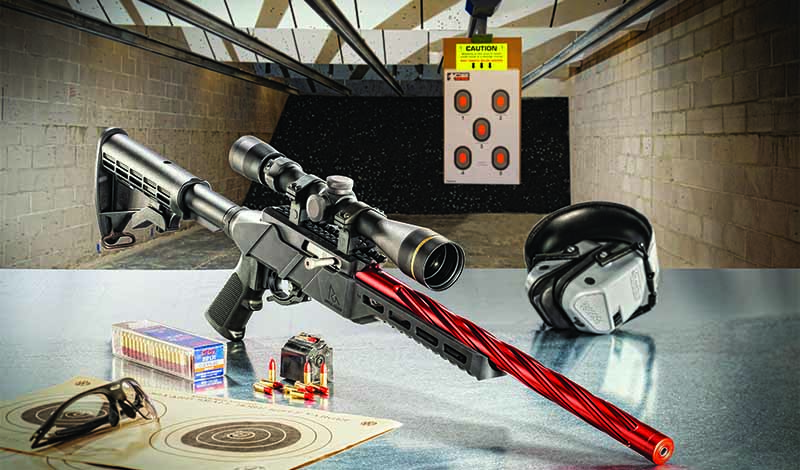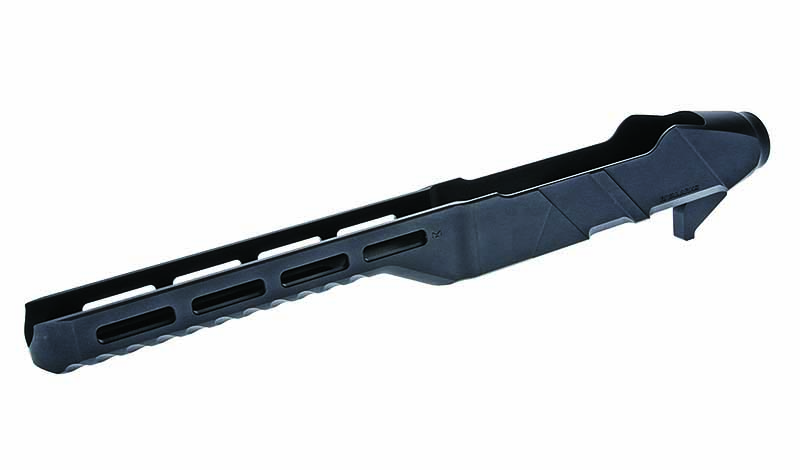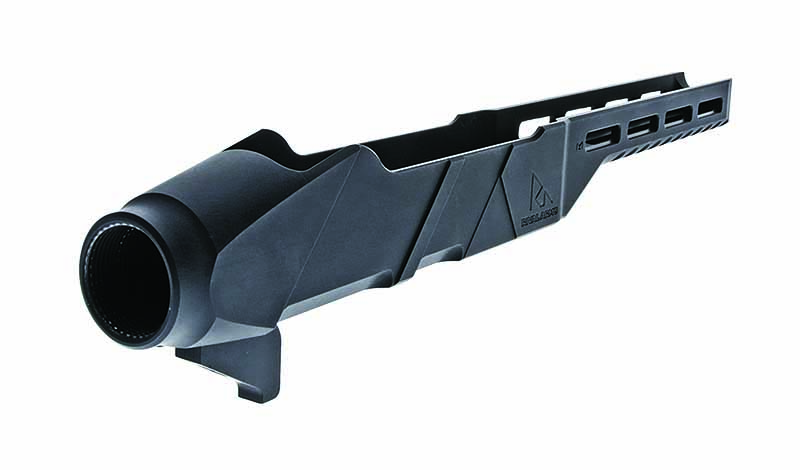
Welcome to 21st-century plinking, thanks to the Rival Arms R-22 … and aluminum.
The dude may abide, but this is America; innovation abounds. Many of us just can’t help ourselves: We have to improve things, make them better and, as a result, everyone benefits from those who just can’t leave things alone.

When the Ruger 10-22 hit the market in 1964, Ruger was just looking for a plinker to compete with all the others. In 1964, a self-loading .22 LR rifle would cost you somewhere between $45 and $55. (Adjusted for inflation, that’d be $370 to $455 in Biden dollars.) The Ruger was right there at the top of the heap, with a list price of $54.95.
Functionally, they were all the same: Load the magazine, chamber a round, shoot until it was empty (10 shots, mostly) and then repeat. Where the 10-22 differed was in design. And time of design. All the existing rifles of the time had been designed years, or even decades, before. They mostly fed through tubes under the barrel, although some had five-round box magazines. The barrels were pressed into aluminum or steel receivers and held in place by means of cross-pins.
Some, like the Marlin Model 60, had firing mechanisms that were complex assemblies of mousetrap springs and stamped-steel parts, between steel rails with the cross-pins “C” clipped into a package. The trigger was what the trigger was, and there was no way on earth to improve it. Anyone rash enough to take one apart for cleaning found it impossible to reassemble and having a gunsmith like me do the job was almost as expensive as buying a replacement.
Accuracy was “minute of tin can,” and reliability for any in the pack was assumed to be marginal. After all, it was “just a plinker.” Part of that unreliable reputation was the tube magazine. Trying to design, then make—and keep in tune—a feed mechanism that’d take a round from the tube and place it in front of the bolt wasn’t easy. The Ruger rotary magazine made that aspect a non-issue.
Then, a strange thing happened. Shooters started to figure out that the 10-22 wasn’t just another plinking rimfire. The method of barrel attachment was the start. Gone was the pinned-in attachment. Instead, the 10-22 uses a clamp that hooks onto a bevel machined into the barrel and pulls it into the receiver.
Anyone with the right-sized Allen wrench could swap barrels. If you wanted a better barrel, you could simply order it and install it yourself. Accuracy improved. The receiver is simply an aluminum shell to hold the bolt and recoil spring. Instead of bolting the receiver to the stock and letting the barrel hang, builders bedded the barrel at the chamber to the stock and let the receiver hang off the back. Accuracy improved even more.

The trigger mechanism was dead-simple, easy to remove and clean and easy to improve. So, shooters did. Then, gunsmiths and parts makers started making improved parts. Triggers got better. Along with triggers, the lower half got improved bolt-release levers, safety buttons, and magazine releases. Oh, and the rotary magazine? That got improved also, and now you can have magazines up to 25 rounds in capacity, even from Ruger themselves.
Through it all, the stock remained a stock. Oh, there were laminates and synthetics and exotics, but they were still stocks.
Then, the world went AR-15 crazy, and if it wasn’t an AR, it wasn’t something people looked at.
Be Gone With The Wood
Rival Arms now offers a solution to the last of the problems.
The Rival Arms R-22 chassis system offers all kinds of features, and they’re in sync with the modern shooting marketplace. First of all, it’s a single- piece aluminum chassis. The problem with wood stocks, even laminated ones, is that they absorb water. If you’ve found a way for aluminum to absorb water, tell the biggest engineering school you can find, because you’ve done the impossible, and people who can do the impossible can make money at it. Synthetics can warp in the sun or heat, but aluminum won’t. Well, it will, but by the time it gets to the temperature that an aluminum chassis will sag from heat, we’re all toast because the sun has gone nova.

The forend of the chassis is slenderized. Rival Arms calls it scalloped, so you can get a good firm hold on the front end while you’re dealing chaos and destruction on tin cans. The slots on the forend are M-lok, so you can easily kit it out with whatever accessories you want. There’s also a tapped sling swivel location, in case you want to put a sling on your upgraded 10-22.
On the back end, Rival Arms has made life easy. The rear of the chassis accepts standard AR-15 stock assemblies, so you can put on whatever kind of stock you want. Or, if you’re building a pistol, then an arm brace that attaches to an AR receiver socket. So, you have the full range of options. You can (keep an eye on the laws and regs, please; you can’t necessarily go swapping back and forth here on the full range of options) build it as a full-sized rifle, with fixed stock, as a rimfire service rifle or Appleseed loaner, right down to a pistol-barrel arm-braced (even a folder) handy firearm to plink with or keep as an emergency tool in your truck, boat or plane.
And to complement that, the Rival Arms R-22 chassis also accepts most AR-15 pistol grips. Just bolt it right on the exact same way you would on an AR-15.
The chassis is CNC machined from billet aluminum, anodized and then if black isn’t your thing, given a Gun Kote FDE or Stealth Gray coating. Need I point out that as an anodized aluminum part, you yourself can give it a “rattle-can camo” finish of your own choosing? Make it camo to match your surroundings, or some splash of neon colors to suit your competitive streak.
To complete the ensemble, it’s a snap to mount a scope, since that has been possible from the beginning with the 10-22, due to the receiver being drilled and tapped for a scope mount base. You can certainly attach a scope to the receiver, and it’ll be more accurate than most shooters. However, for maximum accuracy, shooters have discovered the best way to attach a scope is with a mount secured to the barrel itself.

And speaking of barrels, not only will the R-22 accept factory barrels, but you also have enough room for match barrels up to 1 inch in diameter. Fair warning: If you go with a barrel that big, you’d better have eaten your Wheaties, because it’s going to make the resulting rifle pretty heavy. But really accurate.
The evolution of the 10-22 is now complete, with the Rival Arms R-22 chassis. So complete has the evolution of high tech and innovation been that you could, if you wished, purchase and assemble a “10-22” rifle in which not a single part came out of a Ruger factory. In that, it’s very much like its contemporary of the era, the AR-15. It used to be if you wanted an AR-15, you had to buy a Colt. It used to be if you wanted a 10-22, you had to buy a Ruger. Now, you can assemble the best parts available for your 10-22 and put the assembled receiver into your Rival Arms R-22 chassis.
Have fun.
Editor's Note: This article originally appeared in the February 2021 issue of Gun Digest the Magazine.
More On-Target Rimfire Info:
- Ammo: Evolution of the Red-Hot .17 HMR
- The Return Of The Red-Hot .17 Mach 2
- Cartridge Debate: .17 HMR vs. .17 WSM
- .22 WMR Vs .22 LR: Application Defines This Rimfire Rumble
- The .22 LR And Its .22 Rimfire Cousins

Next Step: Get your FREE Printable Target Pack
Enhance your shooting precision with our 62 MOA Targets, perfect for rifles and handguns. Crafted in collaboration with Storm Tactical for accuracy and versatility.
Subscribe to the Gun Digest email newsletter and get your downloadable target pack sent straight to your inbox. Stay updated with the latest firearms info in the industry.

![Best Concealed Carry Guns In 2025 [Field Tested] Wilson Combat EDC X9S 1](https://gundigest.com/wp-content/uploads/Wilson-Combat-EDC-X9S-1-324x160.jpg)


![Best 9mm Carbine: Affordable PCCs [Tested] Ruger Carbine Shooting](https://gundigest.com/wp-content/uploads/Ruger-Carbine-Shooting-100x70.jpg)
![Best AR-15: Top Options Available Today [Field Tested] Harrington and Richardson PSA XM177E2 feature](https://gundigest.com/wp-content/uploads/Harrington-and-Richardson-PSA-XM177E2-feature-100x70.jpg)

https://gundigest.com/rifles/ar-ing-your-ruger-10-22-with-the-rival-arms-r-22/comment-page-1#comment-61837